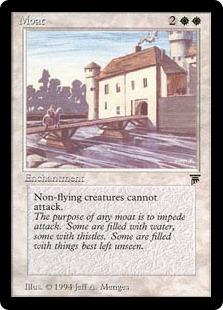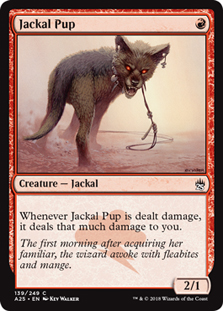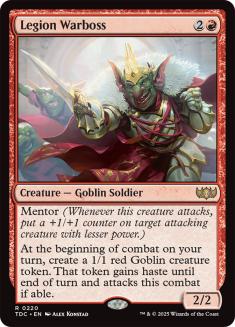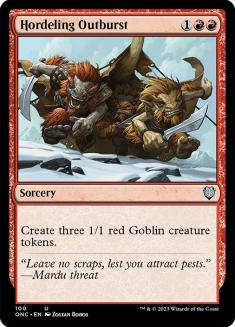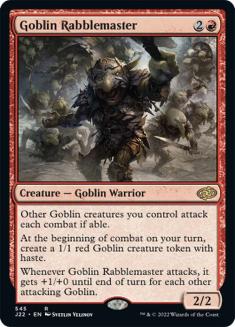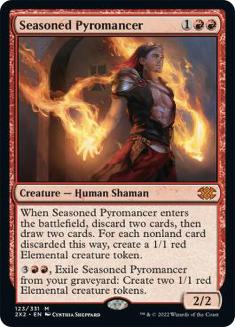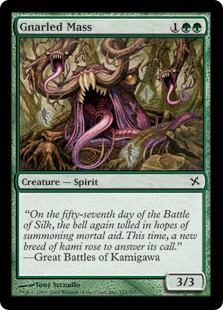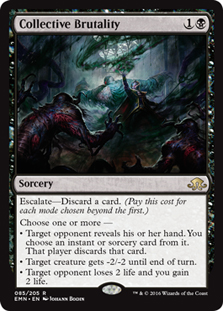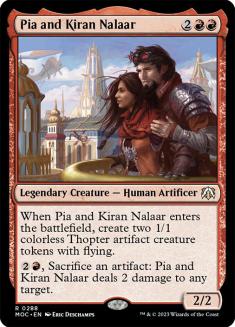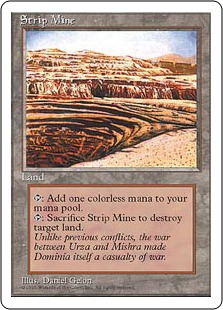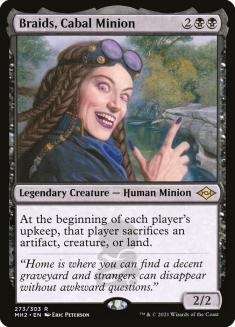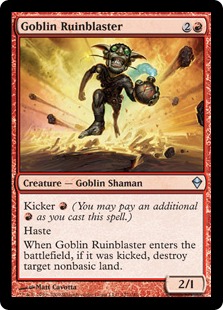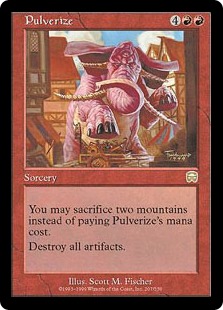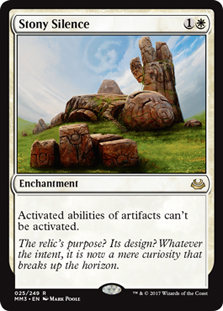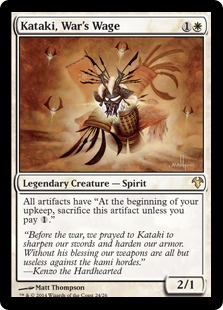A few years back I found myself in a conversation about whether or not Moat was an appropriate card for Cube. I scoffed at the notion. My argument against it, rooted somewhat in the comedy rule of threes, was that the card wasn’t good, interesting, or fun. This snap reaction ended up framing how I came to consider individual cards for Cube inclusion from that point on.
This is hardly a matter of air-tight logic or anything of the sort, and I reiterate that the above statement was mostly a joke at its first utterance, but still it’s one that I’ve found a lot of value in in retrospect. The original Cubes were simply samplings of Magic‘s most powerful cards and the games are played for fun, after all.
Whether a card is good, interesting, and fun is a relative and subjective matter, but that doesn’t mean that there’s no meaningful way to discuss evaluating cards under this lens. Today I’m going to break down these three criteria using examples from my Cube and others to shine some light on how to craft enjoyable Cube environments by critically analyzing individual card choices.
For folks who enjoy a good mnemonic, let’s talk about how to GIF your Cube.
Good
When I ask myself if a card is good for a Cube, I’m not asking whether it is a powerful card, but rather whether it is an appropriately powerful card. Is this card strong enough for players to be happy to put this card in their decks? Will other players be unhappy to play against this card? Does this card severely diminish the value of other cards in the environment?
I’m going to harp on Moat for a bit here, because it’s really difficult for Moat to look good when these questions are asked of it. Moat’s effect is a static ability that aims to stop you from losing the game, which as a category is less powerful than an ability that aims to win the game. Moat can’t stand on its own merits; it has to score points from lining up well against opposing strategies. And it does so by… diminishing the value of other cards in the environment and making players unhappy to play against the card…
You can fight back against Moat by having a lot of flyers or alternate win conditions, but then the pendulum swings the other way. Moat ultimately finds itself in a space where it does very little or nothing in some games and completely ends the game in others. When Moat is involved in a game it means that at least one player is up to something that isn’t good relative to the game being played.
The value of individual cards fluctuates in different environments and from game to game, and it’s impossible to make every card appropriately powerful in every context, but Moat really pushes this concept to its extreme. A counterexample to this would be Jackal Pup. Jackal Pup is very weak if you put it in an environment heavily mired in combat and filled with damage-based removal spells. Alternatively, in environments where Mono-Red Aggro is one of very few creature-heavy decks and/or the red decks have a lot of tools to remove blockers, Jackal Pup does its job admirably.
Jackal Pup can also be viewed more leniently by virtue of being a one-mana creature. There are only so many options and you need a high volume of one-drops to support aggro decks. Slots that have more varied options require a bit more attention. Something that I’ve really come to dislike is having worse versions of extremely similar cards in the same Cube. I’m a little miffed when I look back at my Magic Online (MTGO) build of Grixis Cube when I look at these two cards:
Next to these two cards:
I would like to issue a formal apology to anybody who cast a Hordeling Outburst during that run into an opposing Seasoned Pyromancer. You didn’t deserve that and I can do better.
Again, some cards are just better or worse than others, but there are enough unique cards that it’s not necessary to fill up on similar cards that occupy similar roles when you can just provide players with whichever option is most appropriate for the environment and avoid the unfortunate matchups where one player’s cards are functionally similar and just worse than their opponent’s.
The other side of this is that some cards are just going to be too powerful for your Cube. In my introductory Cube article I established that the highest power level I wanted for an individual card in my Grixis Cube landed somewhere between Grim Monolith and Mana Vault. It’s not essential to establish anywhere near as fine of a line, but you definitely can’t just be putting Sol Ring in your unpowered Cube or Umezawa’s Jitte in an environment that’s all about combat. Cards that are the most powerful thing going on in the overwhelming majority of games that they’re drawn in are simply unfit for Cube inclusion.
Ask if individual cards are at an appropriate power level for the decks you aim to support. If they’re not, ask what makes this so. Is it a symptom of the card’s nature or of the environment you’re crafting? From there, include or exclude the card based on your answers or modify your environment if you would prefer things to function differently.
Interesting
Whether something is interesting is really more of a subjective matter, though I think we can mostly agree that if you’re not personally interested in a card it’s probably not something that’s going to make it into your Cube. There’s no accounting for taste, though there is still a more general discussion worth having here. Whether a given card is interesting in a Cube could be considered a matter of whether that card is appropriately complex.
Complexity isn’t inherently a good or bad thing, though I imagine that most Cube designers are interested in a healthy amount of it. Some vanilla creatures are fine, though it’s really hard to argue that a Cube that’s very heavy on that sort of thing will lead to games that most players find interesting. Isamaru, Hound of Konda gets a pass similar to the one that I gave to Jackal Pup for being a one-drop, but I’m going to look at you sideways if I open a Gnarled Mass in a Cube pack.
Let’s go back to Moat for a second. Moat is extremely reductive on gameplay. If one player controls a Moat, the game is suddenly about a very small number of things. Suddenly, “Is my deck capable of winning in ways other than attacking with non-flyers?” and if not, “Can I get that Moat off of the battlefield?” become the only relevant considerations. There’s a point where games can have too many relevant considerations and they can become uninteresting for that reason, though the more likely and avoidable concern when it comes to Cube is having games be about too few things. That’s really going to damage your Cube’s replayability.
In this sense, Gnarled Mass has more in common with Moat than it might seem at a glance. Gnarled Mass does at most two different things. It has the ability to attack and it has the ability to block. It offers no inherent ability to generate synergies and has no abilities that modify how good it can be at attacking or blocking on a given turn. I don’t think that Gnarled Mass has made it anywhere near most people’s Cubes, though I do believe this example is illustrative of the sorts of questions you should be asking when evaluating creatures for Cube inclusions. Some creatures can speak for themselves on rate alone, but for many of them you’ll want to ask if the considerations beyond the creatures inherent ability to attack and block enrich gameplay.
Ultimately, cards with higher complexity tend to be maindeckable in more situations. Modal spells and activated abilities give players options to consider and just make cards relevant in more situations. Collective Brutality is a great Cube card, as it does something relevant against a wide range of opponents and the escalate cost generates interesting decision trees. Pia and Kiran Nalaar is another Cube all-star for being a very reasonable creature on rate that synergizes with artifacts and offers a mana sink as well.
There’s a line you can cross. I don’t know what Takklemaggot does. I don’t want to know. I also think that Cubes that lead to very wide battlefields benefit a lot from having clean answers to permanents. It’s really difficult to have to constantly assess every game action against the opponent controlling Woe Reaper, Blood Artist, several tokens, and two morphs, all while they still have three cards in hand. Promoting some of this by having few, if any, sweepers has its charm, but access to some amount of cheap removal and other ways to simplify the battlefield will help to curb the overwhelming amount of information to consider in games like this.
Including some Goblin Guides and some Doom Blades and other cards that serve narrow purposes is somewhat inevitable and desirable, but generally speaking the more options that a card provides, the more it will enrich games and lend to your Cube’s replayability.
Fun
Finally, we come to the most subjective of the three criteria. There are many different ways to have fun playing games, and you’ll want to solicit feedback from your playgroup as you try to optimize fun for the people that you play with.
Some players are going to like having Moat around, and if that’s what your group likes, then that’s the correct way to design your Cube! I can hardly claim innocence in the matter of liking cards that are generally unfun to play against, as I derive a sick pleasure from destroying mana sources.
Generally speaking though, being told that you can do something is a lot more fun than being told that you can’t. When drafting, players select the cards that they want to play with and their intention is for their game actions to matter. Cards that say you can’t do something tend to be the most likely cards to diminish this experience. Moat says your creatures can’t attack. Strip Mining your land means you can’t cast your spells. Interaction is good and engaging, but hitting the off switch on a large percentage of your opponent’s options is unlikely to result in games that both players enjoy.
How artifacts are handled in high-powered Cubes is a good case study in how to keep things fun. Putting a lot of mana-generating artifacts in a Cube leads to a lot of explosive plays, and the power level of these decks is typically curbed by artifact destruction. Abrade is commonly found in these environments and the MTGO Vintage Cube has options as powerful as Ancient Grudge. Even still, cards like Pulverize and Stony Silence are excluded. It’s just kind of miserable to facilitate building certain kinds of decks and to pull the rug out from under anybody who tries. It’s good to have options to push back against these decks as they can be quite powerful, but outright hate cards just lead to miserable play experiences.
I don’t think it’s important to go as deep as to give cards grades on sliding scales in all three of these categories; rather, I think these criteria provide a good framework for general considerations about individual cards and environments. I don’t think Hellrider is a particularly interesting card, but it’s very good in red decks and I have fun alpha striking and dealing large quantities of damage, so on balance I like the card quite a lot in Cube.
Just so we have this all in one place, you’ll want to explore the following three questions when evaluating cards and elements of your Cube environment:
- Good: Is this appropriately powerful?
- Interesting: Is this appropriately complex?
- Fun: Will my playgroup enjoy this?
Not every card is going to be a home run, but when you ask these questions you’ll want to exclude any card that can’t get on base.


